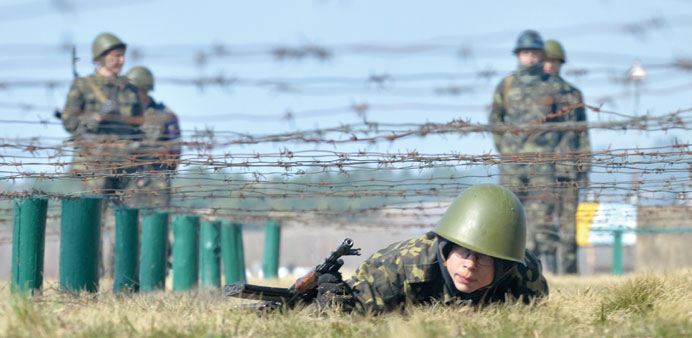By Fran Blandy, AFP
A hail of gunfire rings out as a group of soldiers leap from a helicopter, do a combat roll, crouch and open fire.
Running through a haze of smoke, clambering up and down ropes and engaging in hand-to-hand combat: Ukraine’s newly-formed National Guard is hard at work learning to defend the crisis-hit country.
At a military base in Novi Petrivtsi north of Kiev the recruits are showing off their new skills to the country’s interim President Oleksandr Turchynov, many of them drawn from the protesters whose uprising led to the fall of the previous government.
As loud explosions in the distance shake the ground, black-clad men rappel off a roof into the windows of a building, demonstrating special operations tactics.
“Are all of them volunteers?” Turchynov turns and asks Interior Minister Arsen Avakov, who confirms that they are.
Thousands have signed up to be part of the National Guard, created in early March as Russia seized control of the Black Sea peninsula of Crimea and massed troops on Ukraine’s eastern border.
Moscow’s moves came after Turchynov and his pro-European government swept to power on the back of a deadly popular uprising that ousted Ukraine’s Kremlin-friendly regime.
Amid fears in Kiev and abroad that Russia may attempt further seizures of Ukraine’s heavily-Russified east, the country has been forced to take stock of a long-neglected army.
Before the crisis, Ukraine’s underfunded force consisted of about 130,000 soldiers, half of them conscripts, with ageing and limited equipment.
And as a result of Russia’s annexation of Crimea where Ukraine’s maritime forces were based, the country’s military assets were decimated by the loss of warships, helicopters and fighter jets as well as some 15,000 troops who decided to defect to the Russian army.
Mykola Sungurovskiy, a military expert at Kiev’s Razumkov research centre said Ukraine’s current army could “repel enemy forces in two or three directions but not a massive attack”.
At Kiev’s Independence Square, the crucible of the protest movement, massive posters urge people to sign up to the new unit.
Avakov told journalists at the military base that some 32,000 permanent troops had joined the new force, with 20,000 reserves.
“How do you feel here? Are you well fed?” Turchynov asks a group of recruits who have just finished pulling themselves along monkey bars.
“Yes, everything is okay,” they answer enthusiastically.
He moves on to inspect a line of soldiers in full military regalia, bayonets glinting in the spring sun as an army band begins to play.
Next, an inspection of an array of assault rifles, sniper rifles, rocket launchers and riot gear such as bulletproof vests and shields, all made in Ukraine.
“These things are five times cheaper than foreign-made items,” an officer tells Turchynov.
Further on, an experimental spy drone whizzes above the president’s head.
The drone, like much of the armament and material on display, is not yet in service by the army. It will be up to the government elected on May 25 to adopt a budget allowing for their purchase, an officer explains to AFP.
Along with the creation of the National Guard, Ukraine’s interim authorities approved more than $600mn (435mn euros) in emergency military funding, a significant boost to what in 2012 was a military budget of around $2bn, or 1.1% of GDP, according to defence ministry figures.
“The National Guard of Ukraine was created in a dramatic period,” Turchynov told reporters. “In peacetime it should protect citizens from danger and crime. In times of war it should resist the enemy’s army and defend the country.”
Russia was reported to be withdrawing some of its troops from Ukraine’s borders after a flurry of diplomatic activity, but new recruits like Oleksandr, 20, say they are “ready for any eventuality”.
Those who battled riot police in the winter protests that left around 100 dead have swapped their tents on Independence Square for khaki military tents in Novi Petrivtsi.
Morale is high among the ragtag group, some with beards and others with a Cossack-style haircut featuring hair sprouting from the top of the head but shaven on the sides.
“If there was no external threat to the country from Russia I would not be here, but Russia could attack so I am needed,” said 22-year-old Vasyl, who was a builder before joining the protest movement.
Vadym, 31, originally from the western city of Lviv, said he was an engineer before quitting his job to join the revolution.
“If need be I am ready to fight,” he told AFP. “I am not sure that I will stay if Russia does not attack us but I want to remain in the reserves.
“We do exercises for 18 hours every day so I think we are ready to defend Ukraine. (Russian President Vladimir) Putin should think twice before attacking us.”

